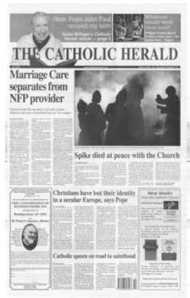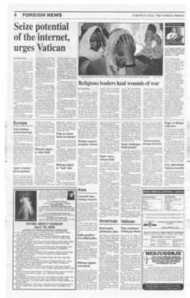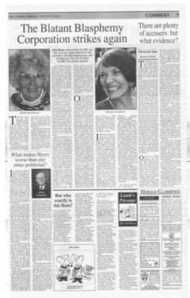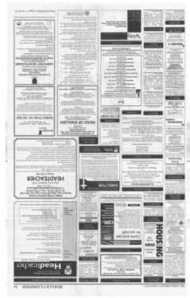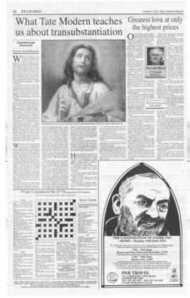Page 12, 8th March 2002
Page 12

Report an error
Noticed an error on this page?If you've noticed an error in this article please click here to report it.
Tags
Share
Related articles
The Damning Of Incense
Charterhouse Chronicle
When Is Spin A Serious Sin .
A Former Editor Who Was
Difficulties About The Theory Of Transubstantiation Can...
A Time When Christianity Was A Primitive Religion
What Tate Modern teaches us about transubstantiation
Charterhouse Chronicle
Quentin de la BOdoyere
Would you expect to find occasion for meditation on the Real Presence in the majestic halls of Tate Modem? On a recent visit with my grandchildren I encountered a piece by Michael Craig-Martin with the title "An Oak Tree". Nothing strange about that except that the piece appeared to be no more than a glass of water on a shelf. Fortunately for the lay viewer a record of dialogue with the artist was provided. When challenged that it looked like a glass of water rather than an oak tree. the artist replied that he had never claimed to have changed its appearance — merely its identity.
At the artistic level he was making the point that the artist as creator had complete control over the identity of the object he had made. If he decided it was an oak tree there could be no further argument — the creator's intention rules. "Bunkum" you might say — and as my wife actually did say. But it set my mind thinking.
When Rene Magritte produced a drawing of a pipe bearing the words "Ceci n'est pas one pipe" he was making the point that this was only the picture of a pipe — not the real thing. He had, in philosophical terms. provided the appearance or accidents but not the substance. Craig-Martin is claiming that he has changed the substance but not the appearance. Transubstantiation, as defined at Trent and further specified in Mysterium Fidel (1965), makes the same claim. The substance of the bread and wine is changed into a "new reality which we may justly term ontological . . . nothing remains of the bread and wine except its appearances." However, we should perhaps remember that. unlike CraigMartin and Magritte, Christ is the supreme artist and the supreme creator. "Ceci n'est ni pain ni yin." Art has much to teach us. And given that on some estimates no more than 30 per cent of westem Catholics today believe in the Real Presence. we have much to learn.
When the history of the Church over the last, and perhaps the next. 50 years is told what will be the major theme? I suspect that a strong candidate will be the changing attitudes to authority. Crudely polarised, the issue has been between a traditional model of the Church as an hierarchical triangle characterised by the power of authority, and the Church seen as a . community within which authority operates primarily through leadership. The trumpet of Vatican II gives an uncertain sound — some passages are claimed to support one view and others to support the opposition. What do we make, for instance, of the emphasis on the sovereignty of conscience only to find that the conscience must be formed by the teaching of the Magisterium? The constitutions and decrees reflect the tensions which were present throughout the discussions.
A key document which the historian will note is the lecture given by Archbishop Quinn (of Chicago) at Oxford. It is a response to the Pope's call for assis
tance in developing the papacy to make it more comprehensible to other Christians. In proposing quite radical reforms in the exercise of authority it certainly set the battle lines. A British contribution, Governance and Authority in the Roman Catholic Church (SPCK), reflects a symposium of views emanating from a conference in 1997. Both at least implicitly respond to a background of gross decline in practice and vocations in the United States and Europe since the 1960s. These works, and much theology written today. incline to the liberal end of the spectrum. Less has been written in defence of the traditional approach. though an important contribution by way of powerful essays appears in The Battle for the Catholic Mind (St Augustine's Press).
The debate might be seen as centring on the issue of subsidiarity. This principle — that higher authority should never arrogate what can properly be decided at lower level — is enshrined in the Church's social teaching, and was specifically applied to the life of the Church by Pope Pius XII "without prejudice to her hierarchical structure". For some, subsidiarity has become synonymous with rampant republicanism, and indeed the balance between the exercise of direct authority and the encouragement of autonomy is a difficult one to achieve. Despite Pope John Paul's warning that the Church must not be organised as "if she were a multinational corporation and thus subject to a purely human form of authority", it is interesting that secular organisations have discovered that maximising the autonomy of their people at different levels has not only been of direct benefit to their objectives but has tended to lead an increase in the influence of leadership authority.
There will always be a tension between authority and autonomy but I believe that getting a satisfactory balance (known in business as the "tight-loose" principle) will decide whether the Church becomes an increasing influence for good or declines into perceived irrelevance.
Having recently reviewed La Rochefoucauld's Maxims I was tempted to write a few myself. Currently I've reached 138 — which suggests it's not all that difficult However quality is another matter — so here's a brief selection for you to judge.
A group defines itself as much by the way it is hated, as by the way it is loved. So for countries, and for races, and for individuals.
I leave you to rejoice in the widow's mite; I will be humbly content with the rich man's treasure.
Those who have suffered most from injustice are the first to inflict the same injustice on others.
The brain has two reference points one for the judgement of others' behaviour and one for the judgment of our
own.
It is only the deeply depressed who can see the world as it really is. Recovery is a process of reconstructing the fictions which make life bearable.
A professional is someone who uses his skills for you benefit ahead of his personal interests. By that definition a plumber may be more professional than a lawyer.
A person who says he envies us our faith might as well say how nice it would be to believe in fairies.
To describe something as metaphorical is to suggest that it is not really true. But there are two potential truths the superficial truth of the logical proposition and the sub-cutaneous truth of the metaphor.
To change a man's mind from black to white it is only necessary to have enough shades of grey.
blog comments powered by Disqus


